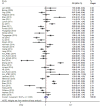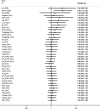Altered mitochondrial DNA copy number contributes to human cancer risk: evidence from an updated meta-analysis
- PMID: 27775013
- PMCID: PMC5075889
- DOI: 10.1038/srep35859
Altered mitochondrial DNA copy number contributes to human cancer risk: evidence from an updated meta-analysis
Abstract
Accumulating epidemiological evidence indicates that the quantitative changes in human mitochondrial DNA (mtDNA) copy number could affect the genetic susceptibility of malignancies in a tumor-specific manner, but the results are still elusive. To provide a more precise estimation on the association between mtDNA copy number and risk of diverse malignancies, a meta-analysis was conducted by calculating the pooled odds ratios (OR) and the 95% confidence intervals (95% CI). A total of 36 case-control studies involving 11,847 cases and 15,438 controls were finally included in the meta-analysis. Overall analysis of all studies suggested no significant association between mtDNA content and cancer risk (OR = 1.044, 95% CI = 0.866-1.260, P = 0.651). Subgroup analyses by cancer types showed an obvious positive association between mtDNA content and lymphoma and breast cancer (OR = 1.645, 95% CI = 1.117-2.421, P = 0.012; OR = 1.721, 95% CI = 1.130-2.622, P = 0.011, respectively), and a negative association for hepatic carcinoma. Stratified analyses by other confounding factors also found increased cancer risk in people with drinking addiction. Further analysis using studies of quartiles found that populations with the highest mtDNA content may be under more obvious risk of melanoma and that Western populations were more susceptible than Asians.
Figures




Similar articles
-
The relationship between altered mitochondrial DNA copy number and cancer risk: a meta-analysis.Sci Rep. 2015 May 8;5:10039. doi: 10.1038/srep10039. Sci Rep. 2015. PMID: 25952580 Free PMC article.
-
Association between mitochondrial DNA copy number and cardiovascular disease: Current evidence based on a systematic review and meta-analysis.PLoS One. 2018 Nov 7;13(11):e0206003. doi: 10.1371/journal.pone.0206003. eCollection 2018. PLoS One. 2018. PMID: 30403687 Free PMC article.
-
Mitochondrial DNA copy number in peripheral blood and melanoma risk.PLoS One. 2015 Jun 25;10(6):e0131649. doi: 10.1371/journal.pone.0131649. eCollection 2015. PLoS One. 2015. PMID: 26110424 Free PMC article.
-
Reduced mitochondrial DNA copy number in peripheral blood leukocytes increases the risk of soft tissue sarcoma.Carcinogenesis. 2013 May;34(5):1039-43. doi: 10.1093/carcin/bgt023. Epub 2013 Jan 24. Carcinogenesis. 2013. PMID: 23349016
-
Association Between Mitochondrial DNA Copy Number and Head and Neck Squamous Cell Carcinoma: A Systematic Review and Dose-Response Meta-Analysis.Med Sci Monit. 2021 Jan 20;27:e928327. doi: 10.12659/MSM.928327. Med Sci Monit. 2021. PMID: 33468984 Free PMC article.
Cited by
-
Pathogenic mutations reveal a role of RECQ4 in mitochondrial RNA:DNA hybrid formation and resolution.Sci Rep. 2020 Oct 12;10(1):17033. doi: 10.1038/s41598-020-74095-9. Sci Rep. 2020. PMID: 33046774 Free PMC article.
-
A Longitudinal Study of Individual Radiation Responses in Pediatric Patients Treated with Proton and Photon Radiotherapy, and Interventional Cardiology: Rationale and Research Protocol of the HARMONIC Project.Int J Mol Sci. 2023 May 8;24(9):8416. doi: 10.3390/ijms24098416. Int J Mol Sci. 2023. PMID: 37176123 Free PMC article.
-
Whole-exome sequencing in 415,422 individuals identifies rare variants associated with mitochondrial DNA copy number.HGG Adv. 2022 Sep 26;4(1):100147. doi: 10.1016/j.xhgg.2022.100147. eCollection 2023 Jan 12. HGG Adv. 2022. PMID: 36311265 Free PMC article.
-
Understanding the impact of mitochondrial DNA mutations on aging and carcinogenesis (Review).Int J Mol Med. 2025 Aug;56(2):118. doi: 10.3892/ijmm.2025.5559. Epub 2025 Jun 6. Int J Mol Med. 2025. PMID: 40476552 Free PMC article. Review.
-
Peripheral blood mitochondrial DNA copy number as a novel potential biomarker for diabetic nephropathy in type 2 diabetes patients.Exp Ther Med. 2018 Aug;16(2):1483-1492. doi: 10.3892/etm.2018.6319. Epub 2018 Jun 15. Exp Ther Med. 2018. PMID: 30116398 Free PMC article.
References
-
- Chen X. J. & Butow R. A. The organization and inheritance of the mitochondrial genome. Nat Rev Genet 6, 815–825 (2005). - PubMed
-
- Veltri K. L., Espiritu M. & Singh G. Distinct genomic copy number in mitochondria of different mammalian organs. J Cell Physiol 143, 160–164 (1990). - PubMed
-
- Grzybowska-Szatkowska L. & Slaska B. Mitochondrial DNA and carcinogenesis (review). Mol Med Rep 6, 923–930 (2012). - PubMed
-
- Corral M. et al.. Increased level of the mitochondrial ND5 transcript in chemically induced rat hepatomas. Exp Cell Res 184, 158–166 (1989). - PubMed
Publication types
MeSH terms
Substances
LinkOut - more resources
Full Text Sources
Other Literature Sources
Molecular Biology Databases

